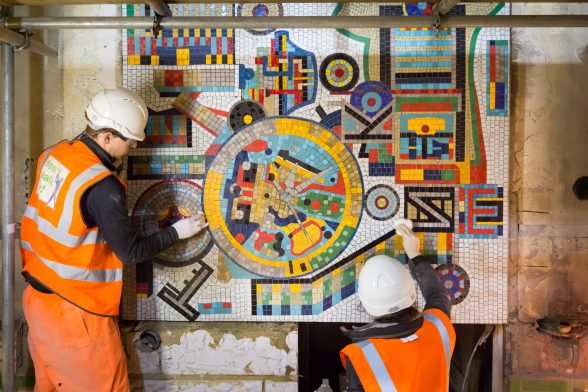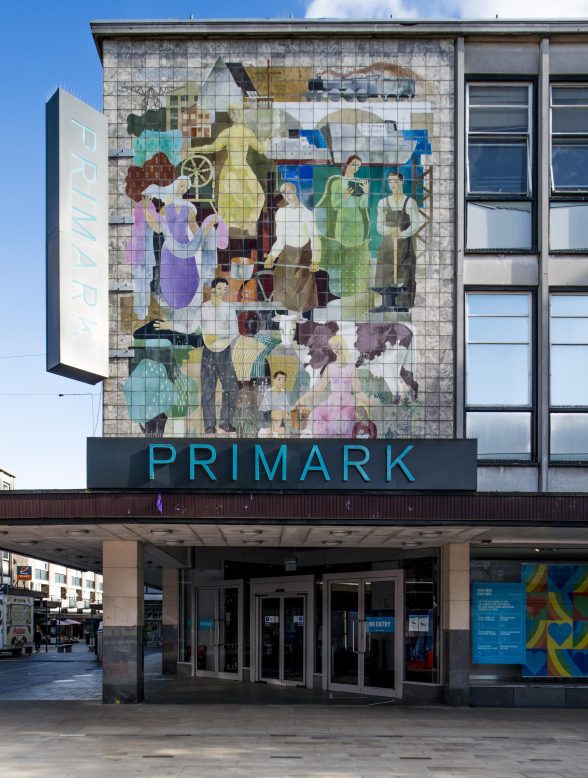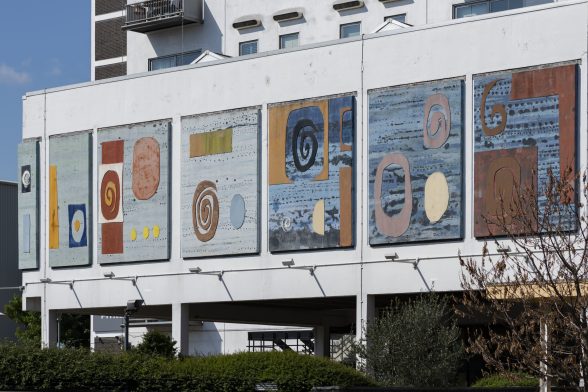This website uses cookies
This website uses cookies to enable it to function properly and to analyse how the website is used. Please click 'Close' to accept and continue using the website.



Image credit: TfL
Murals are for everyone and the post-war years were a time of tremendous experimentation and exuberance for public art – as well as architecture. The C20 Society Murals Campaign hopes to highlight the fact that many murals from the post-war period survive. Listing will be an option for only a small number of them, but many more deserve to survive.
Post-war murals are an endangered species. Although paintings and sculpture from this same period are seen as fit subjects for gallery display and academic study, murals – often by the very same artists – are still frequently ignored and even destroyed.
Mural art was given a huge boost in 1951 by the Festival of Britain, where around 100 murals were shown at the South Bank Exhibition site alone. This increased critical interest in murals, and encouraged artists to use a wide range of materials – eventually including ceramics, metals, plastics, fibreglass, wood and concrete. Combined with the post-war building boom this produced a tremendously fertile period for mural art.

Image credit: Elain Harwood
At least one thousand murals were executed/constructed between WWII and the 1980s, although no definitive record has ever been compiled. Many were located outside London, the majority being commissioned for new schools, universities, civic buildings, offices and churches, as well as restaurants, shopping centres and subways. Their artists ranged from the internationally famous – for instance John Piper, Victor Pasmore, Mitzi Cunliffe, Ben Nicholson, Eduardo Paolozzi, Bridget Riley – to the totally unknown, and the subjects included everything from traditional portraits and illustrations to bold abstracts.
But Britain’s fine stock of murals is diminishing fast, as changing fashions, weather, vandalism and commercial pressures take their toll. Some have been demolished or even buried, as in the shocking case of Plymouth’s Armada Way subway mural (1987-8, Edward Pond and Kenneth Clark), filled in by the local council in 2004.
In Autumn 2008 the magnificent mosaic by Ray Howard-Jones (1903-96) which had decorated Cardiff’s Thomson House since 1959 was unceremoniously reduced to rubble along with the rest of the building. Most recently, Mitzi Cunliffe’s concrete tile mural Cosmos 2 (1963-4) at Sunderland University has been destroyed.
Hundreds of post-war murals have escaped the bulldozers so far, but in order to protect them we first need to find and record them. Many of these murals will be publicly accessible, by virtue of being on the external wall of a buildings or in a prominent position inside a building normally open to the public.
This C20 Society campaign site is a starting point and we need your help to expand it. Please send us any images and information about any other examples of post-war murals that you have seen. They could be in churches, on supermarkets, tower-blocks or in schools. They could be brick, concrete or ceramic and they could be indoors or out. We want to this website to be a rolling archive of the best post-war murals in the UK. We are already working with Dr Lynn Pearson, and from her website you can access the link to an impressive database of post-war murals. It is a great resource. We would also appreciate photographs and more information on any of the murals listed in her post-war murals database – please check if there are any near you.
As you navigate through the murals on our site, you may also see gaps in the information we have put together so far – a reflections of how little information currently exists. If you can help us fill these gaps, or if you have better images than the ones we have so far, please get in touch with us.

Image credit: Historic England
This text needs adding

Become a C20 member today and help save our modern design heritage.